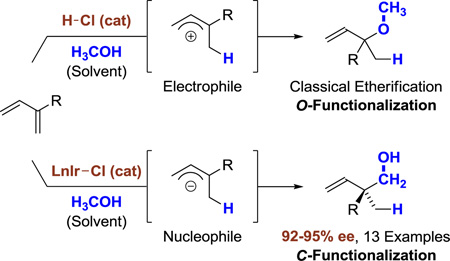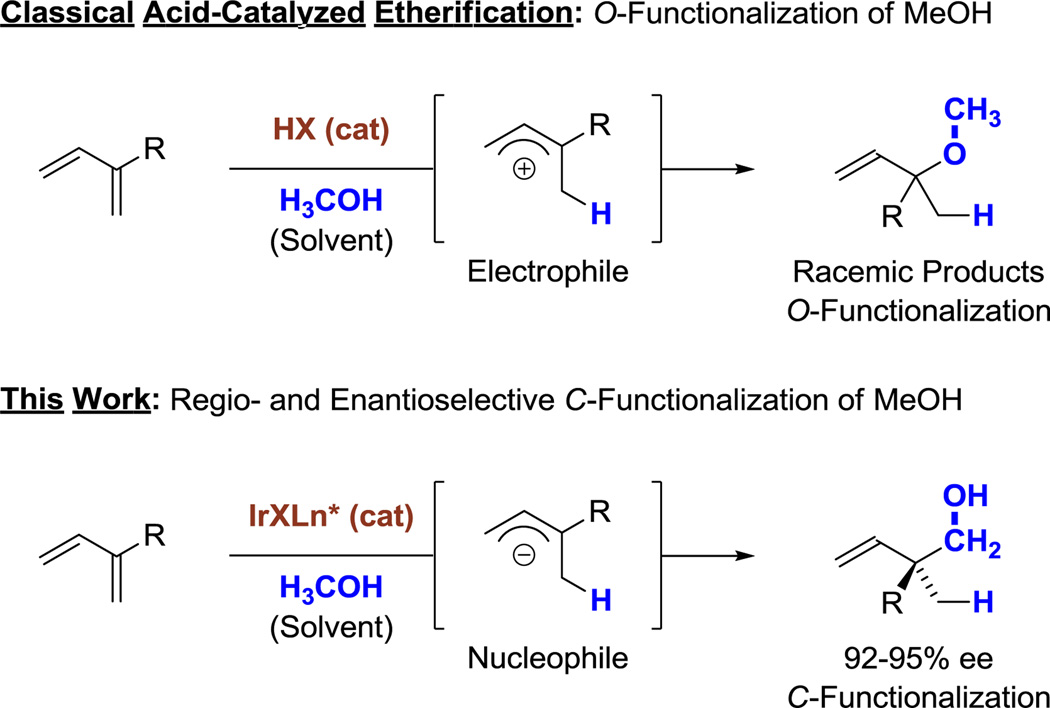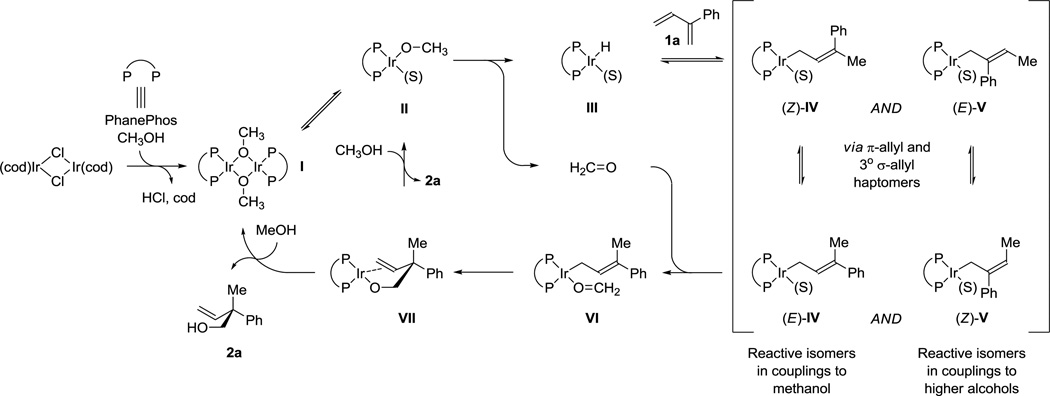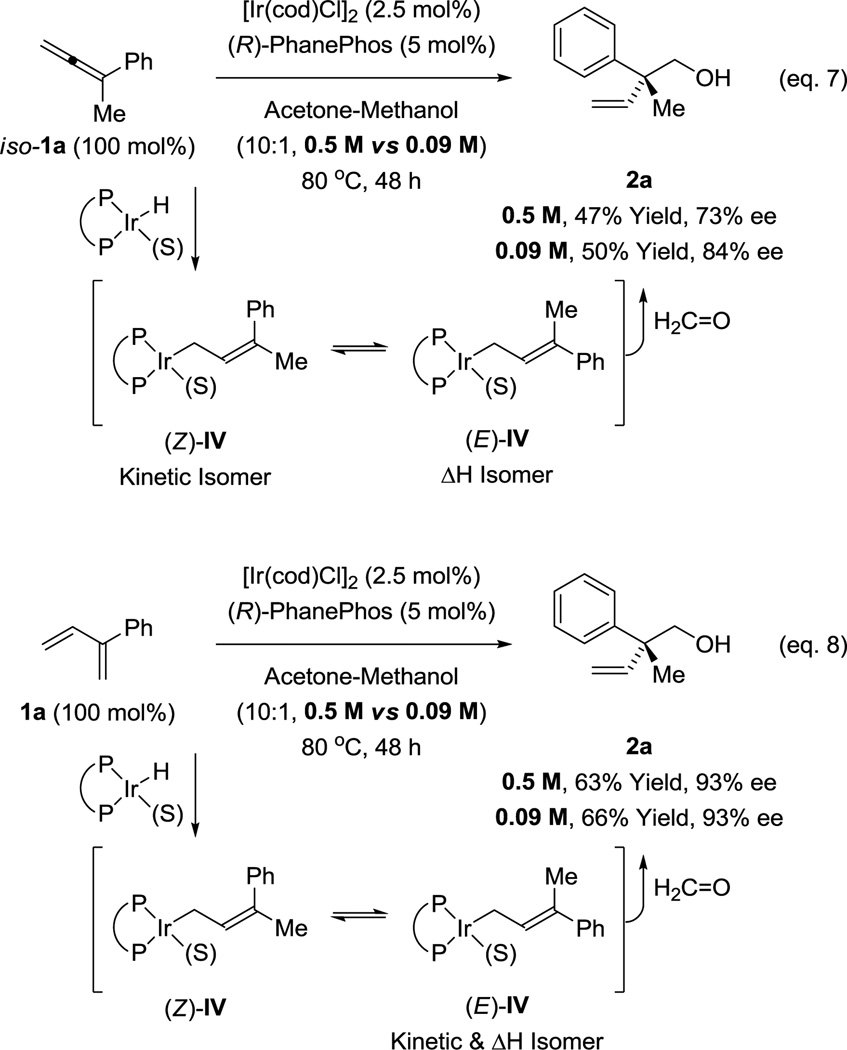Abstract
The first catalytic enantioselective C-C couplings of methanol (> 30× 106 tons/year) are reported. Formal insertion of 2-substituted dienes into the methanol C–H bond occurs in a regioselective manner to form all-carbonyl quaternary centers with excellent levels of enantioselectivity using an iridium-PhanePhos catalyst. Mechanistic studies corroborate a Curtin-Hammett scenario in which methanol dehydrogenation triggers rapid, reversible diene hydrometalation en route to regioisomeric allyliridium-formaldehyde pairs, yet complete levels of regioselectivity are observed.
Graphical Abstract
Despite impressive advances in the field of chemical synthesis, catalytic enantioselective formation of all-carbon quaternary stereocenters remains a daunting challenge.1 Ideally, it would be desirable to form all-carbon quaternary stereocenters from inexpensive feedstocks in C-C bond forming processes that circumvent generation of stoichiometric byproducts. Indeed, the two largest volume applications of homogenous catalysis, hydroformylation2 and methanol carbonylation (the Monsanto/Cativa processes),3 are byproduct-free C-C bond formations. In connection with our development of catalytic C-C couplings that convert lower alcohols to higher alcohols4- processes that merge the characteristics of transfer hydro-genation and carbonyl addition - we became interested in the use of methanol as a C1 feedstock in catalytic C-C coupling.4c,5 Toward this end, the direct byproduct conversion of methanol to higher alcohols was achieved using allene pronucleophiles.6a Methanol-mediated couplings of more abundant π-unsaturated partners (dienes or α-olefins) have hitherto proven elusive and enantioselective transformations of this type appeared especially implausible.6b,7
Here, we report an iridium-PhanePhos catalyst for the enantioselective C-C coupling of methanol (> 30× 106 tons/year) with 2-substituted dienes. Remarkably, mechanistic studies corroborate rapid interconversion of regio- and stereoisomeric allyliridium intermediates, yet a Curtin-Hammett selection process enables formation of single isomeric products bearing all-carbon quaternary stereocenters. Furthermore, enantiotopic π-facial discrimination for the reactive allyliridium isomer is efficient, resulting in high levels of enantioselectivity.8 Thus, by inverting the canonical behavior of methanol in its reaction with unsaturates (etherification), enantioselective C–H functionalization of methanol is achieved for the first time (Scheme 1).
Scheme 1.
Inverting diene reactivity via C-C bond forming transfer hydrogenation: enantioselective formation of allcarbon quaternary centers.
In an effort to develop enantioselective iridium-catalyzed C-C couplings of primary alcohols with dienes to form homoallylic secondary alcohols,9 diverse primary alcohols were exposed to 2-phenyl-1,3-butadiene 1a in the presence of the iridium catalyst generated in situ from [Ir(cod)Cl]2 and various chelating chiral phosphine ligands. An astonishing observation was made: whereas the iridium-PhanePhos cata-lyzed reaction of ethanol with 2-phenyl-1,3-butadiene 1a results in coupling at the diene C3-position to form iso-2a (R = Me), the corresponding reaction of methanol results in coupling at the diene C2-position to form 2a (R = H) in 93% ee (eq. 1). For both reactions, complete partitioning of C2 vs C3 regioselectivity is observed. Underscoring the fortuitous na-ture of these findings, an extensive ligand survey revealed that PhanePhos was unique in its ability to promote efficient formation of 2a (R = H).
 |
(eq. 1) |
The conditions indicated for the formation of 2a (eq. 1) are the result of extensive optimization (see Supporting Information). Diene 1a is susceptible to formation of a Diels-Alder dimerization byproduct, but this side-reaction is largely suppressed at lower temperature. Because diene 1a is far more precious than methanol, it was used as the limiting reagent even though higher yields are possible by inverting stoichiometry. Application of these conditions to 2-aryl substituted dienes 1a–1l illustrates the scope of this process (Table 1). Dienes 1b and 1c, which incorporate electron withdrawing p-substituted phenyl moieties, are converted to the products of hydrohydroxymethylation 2b and 2c, respectively, with excellent levels of enantioselectivity. Dienes 1d–1g, bearing phenyl groups with alkoxy substituents at the para-, meta- and ortho-positions, are converted to adducts 2d–2g with uniformly high levels of enantioselectivity. Finally, dienes incorporating halogenated phenyl moieties (1h–1j) and heteroaromatic rings (1k–1l) perform equally well. The absolute stereochemistry of the 4-bromobenzoate of adduct 2a was determined by single crystal x-ray diffraction analysis. The absolute stereochemistry of adducts 2b–2l were assigned in analogy.
Table 1.
Enantioselective iridium-catalyzed C-C coupling of 2-substituted dienes 1a–1l with methanol to form neopentyl alcohols 2a–2l.a
Yields of material isolated by silica gel chromatography. Enantioselectivities were determined by chiral stationary phase HPLC analysis. See Supporting Information for further experimental details.
Acetone:Methanol (1:1).
The coupling of methanol with dienes bearing alkyl substituents at the C2-position was investigated. As illustrated in the coupling of cyclohexyl-substituted diene 1m under standard reaction conditions (eq. 2), complete levels of C2-regioselectivity are accompanied by excellent levels of enantioselectivity, however, a lower isolated yield is observed. The development of improved conditions for the coupling of C2-alkyl substituted dienes is currently underway.
 |
(eq. 2) |
To briefly illustrate how the present coupling products may serve as building blocks in asymmetric synthesis, alcohol 2b was converted to the corresponding p-toluenesulfonate and reacted with sodium azide in DMSO. Although neopentyl electrophiles are notoriously recalcitrant partners for SN2 reactions, azide 3b was formed in good yield (eq. 3). Additionally, Jones oxidation of neopentyl alcohol 2b followed by Fischer esterification provides the ester 4b (eq. 4). To our knowledge, these structures represent volumes of chemical space that would otherwise be inaccessible.
 |
(eq. 3) |
 |
(eq. 4) |
Regarding the catalytic mechanism, the regiodivergence observed in the coupling of diene 2a with methanol vs higher alcohols suggests a Curtin-Hammett scenario wherein alcohol dehydrogenation triggers rapid, reversible diene hydrometalation to form regioisomeric allyliridium-formaldehyde pairs.10 To probe the veracity of this interpretation, deuterium labelling experiments were performed. The coupling of diene 1b with d4-methanol under otherwise standard conditions provides deuterio-2b in 35% yield (eq. 5). Deuterium is retained at the carbinol position (Hc = >95%2H), suggesting deuterio-2b is kinetically inert with respect to dehydrogenation. The incorporation of deuterium at the former diene C1, C3 and C4 positions is consistent with rapid, reversible diene hydrometalation-β-hydride elimination in advance of carbonyl addition. Incomplete transfer of deuterium is observed, which may be attributed to H-D exchange of the transient iridium hydride with adventitious water.11 A competition kinetics experiments was performed in which diene 1b was exposed to equimolar quantities of methanol and d4-methanol (eq. 6). The incorporation of deuterium at the carbinol methylene (25%2H) of the product deuterio-2b establishes a normal primary kinetic isotope effect (kH/kD = 3.0). These data suggest methanol dehydrogenation is turnover-limiting. This result is not surprising given the relatively high energetic demand of methanol dehydrogenation (ΔH = +84 kJ/mol) compared to the dehydrogenation of higher alcohols, such as ethanol (ΔH = +68 kJ/mol).12
 |
(eq. 5) |
 |
(eq. 6) |
A catalytic mechanism consistent with the collective data has been proposed (Scheme 2). Exposure of [Ir(cod)Cl]2 to PhanePhos in the presence of methanol provides the methoxybridged dimer I,12c–d,13 which exists in equilibrium with the monomeric iridium methoxide complex II. β-Hydride elimination of II generates the iridium hydride III and formaldehyde.12 Reversible diene hydrometalation provides an equilibrating mixture of regioisomeric allyliridium complexes IV and V. Complexation of formaldehyde occurs exclusively by way of the 1,1-disubstituted allyliridium isomers IV to form the formaldehyde complex VI. Carbonyl addition then provides the homoallylic iridium alkoxide complex VII, which upon methanolysis releases the product of hydrohydroxymethylation 2a and regenerates the iridium methoxide complexes I or II to close the catalytic cycle. The regiodivergence observed in the coupling of diene 2a with methanol vs higher alcohols may be rationalized as follows. The 1,1-disubstituted allyliridium species (E)-IV is both thermodynamically preferred and, in the case of formaldehyde addition, kinetically more reactive. Higher alcohols, and therefrom higher aldehydes, impose greater steric congestion, raising the energy of the transition state for carbonyl additions that form all-carbon quaternary centers. Consequently, in additions to higher aldehydes, the 1,2-disubstituted allyliridium isomers V are kinetically more reactive. Rapid, reversible diene hydrometalation, as corroborated by deuterium labelling (eq. 5), replenishes whichever allyliridium isomer that is consumed.
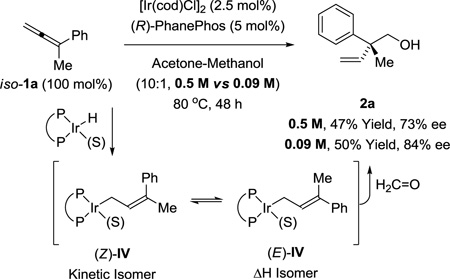 |
(eq. 7) |
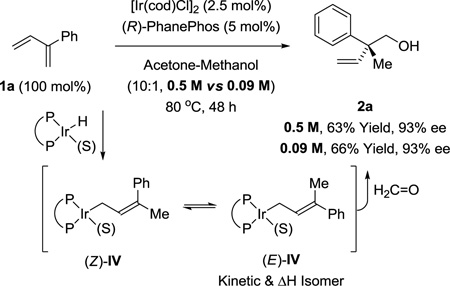 |
(eq. 8) |
Scheme 2.
General catalytic mechanism accounting for regiodivergence in the iridium-catalyzed coupling of diene 1a with methanol vs higher alcohols.
High levels of enantioselectivity in the formation of adducts 2a–2l requires intervention of a single allyliridium geometrical isomer if carbonyl addition occurs in a stereospecific manner through a closed 6-centered transition structure. As dienes bearing sterically demanding groups at the 2-position predominantly reside in the s-cis conformation,14 the hydrometalation of dienes 1a–1l should display a kinetic preference for formation (E)-IV, which is presumed to be thermodynamically more stable than (Z)-IV. The coupling of allene iso-1a provides a unique opportunity to test this hypothesis (Scheme 3, eq. 7). Hydrometalation of allene iso-1a should occur predominantly from the olefin π-face that is “syn” with respect to the relatively small methyl moiety. Thus, for allene iso-1a, hydrometalation to form (Z)-IV is kinetically preferred. Enantioselectivities in the coupling of allene iso-1a are concentration dependent and improve with decreasing concentration. These data corroborate a scenario wherein isomerization of the kinetic allyliridium isomer (Z)-IV to the more stable isomer (E)-IV occurs at a rate that is only slightly faster than formaldehyde addition. For the corresponding diene pronucleophile 1a, enantioselectivity is relatively insensitive to concentration, consistent with the hypothesis that (E)-IV is both kinetically and thermodynamically preferred (Scheme 3, eq. 8).
Scheme 3. Diene hydrometalation delivers the allyliridium isomer that is both kinetically and thermodynamically preferred.a.
aYields of material isolated by silica gel chromatography. Enantioselectivities were determined by chiral stationary phase HPLC analysis. See Supporting Information for further experimental details.
To summarize, by unlocking the native reducing ability of methanol, one can override the canonical SN1 pathways observed in reactions with dienes, that is, O-alkylation, and instead activate catalytic mechanisms for C-alkylation. Furthermore, as demonstrated by the regio- and enantioselectivities evident in the present report, mediation of the catalytic process by transition metals enables unique isomer-selectivities manifesting in the asymmetric formation of all-carbon quaternary centers – and the first enantioselective C-C couplings of methanol.15 Future studies will focus on the development of related transfer hydrogenative C-C bond formations, including the byproduct-free coupling of alcohols with α-olefins.
Supplementary Material
Acknowledgments
The Robert A. Welch Foundation (F-0038), the NIH-NIGMS (RO1-GM069445) and the Feodor Lynen postdoctoral fellowship program administered by the Alexander von Humboldt Foundation are acknowledged for partial support of this research.
Footnotes
Supporting Information Available:
Experimental procedures and spectral data. HPLC traces corresponding to racemic and enantiomerically enriched samples. Single crystal X-ray diffraction data for the 4-bromobenzoate of compound 2a. This material is available free of charge via the internet at http://pubs.acs.org.
The authors declare no competing financial interest.
REFERENCES
- 1.For selected reviews on the enantioselective formation of all-carbon quaternary centers, see: Corey EJ, Guzman-Perez A. Angew. Chem. Int. Ed. 1998;37:389. doi: 10.1002/(SICI)1521-3773(19980302)37:4<388::AID-ANIE388>3.0.CO;2-V. Bella M, Gasperi T. Synthesis. 2009:1583. Shimizu M. Angew. Chem. Int. Ed. 2011;50:5998. doi: 10.1002/anie.201101720. Hong AY, Stoltz BM. Eur. J. Org. Chem. 2013:2745. doi: 10.1002/ejoc.201201761. Minko Y, Marek I. Chem. Comm. 2014:12597. doi: 10.1039/c4cc04391j. Marek I, Minko Y, Pasco M, Mejuch T, Gilboa N, Chechik H, Das JP. J. Am. Chem. Soc. 2014;136:2682. doi: 10.1021/ja410424g. Quasdorf KW, Over-man LE. Nature. 2014;516:181. doi: 10.1038/nature14007. Zeng X-P, Cao Z-Y, Wang Y-H, Zhou F, Zhou J. Chem. Rev. 2016;116:7330. doi: 10.1021/acs.chemrev.6b00094.
- 2.For selected reviews on hydroformylation, see: Beller M, Cornils B, Frohning CD, Kohlpaintner CW. J. Mol. Catal. A. 1995;104:17. Frohning CD, Kohlpaintner CW, Bohnen H-W. In: Applied Homogeneous Catalysis with Organometallic Compounds. Cornils B, Herrmann WA, editors. Vol. 1. Weinheim: Wiley-VCH; 1996. pp. 29–104. van Leeuwen PWNM, Claver C, editors. Rhodium Catalyzed Hydroformylation. Norwell, MA: Kluwer Academic Publishers; 2000. Breit B, Seiche W. Synthesis. 2001:1. Weissermel K, Arpe H-J. Indus-trial Organic Chemistry. 4th. Weinheim: Wiley-VCH; 2003. pp. 127–144. van Leeuwen PWNM, editor. Homogeneous Catalysis: Understanding the Art. Dordrecht: Kluwer Academic Publishers; 2004.
- 3.For selected reviews on Monsanto/Cativa process, see: Jones JH. Platinum Met. Rev. 2000;44:94. Thomas CM, Suss-Fink G. Coord. Chem. Rev. 2003;243:125. Haynes A. Top. Organomet. Chem. 2006;18:179. Haynes A. Adv. Catal. 2010;53:1.
- 4.For selected reviews on C-C bond forming transfer hydrogenation, see: Ketcham JM, Shin I, Montgomery TP, Krische MJ. Angew. Chem. Int. Ed. 2014;53:9142. doi: 10.1002/anie.201403873. Feng J, Kasun ZA, Krische MJ. J. Am. Chem. Soc. 2016;138:5467. doi: 10.1021/jacs.6b02019. Sam B, Breit B, Krische MJ. Angew. Chem. Int. Ed. 2015;53:3267. doi: 10.1002/anie.201407888.
- 5.For selected examples of the use of methanol in catalytic C-C coupling, see: Chan LKM, Poole DL, Shen D, Healy MP, Donohoe TJ. Angew. Chem. Int. Ed. 2014;53:761. doi: 10.1002/anie.201307950. Ogawa S, Obora Y. Chem. Comm. 2014:2491. doi: 10.1039/c3cc49626k. Li Y, Li H, Junge H, Beller M. Chem. Comm. 2014:14991. doi: 10.1039/c4cc06933a. Shen D, Poole DL, Shotton CC, Kornahrens AF, Healy MP, Donohoe TJ. Angew. Chem. Int. Ed. 2015;54:1642. doi: 10.1002/anie.201410391. Quan X, Kerdphon S, Andersson PG. Chem. Eur. J. 2015;21:3576. doi: 10.1002/chem.201405990.
- 6.(a) Moran J, Preetz A, Mesch RA, Krische MJ. Nature Chem. 2011;3:287. doi: 10.1038/nchem.1001. [DOI] [PubMed] [Google Scholar]; (b) Han H, Krische MJ. Org. Lett. 2010;12:2844. doi: 10.1021/ol101077v. [DOI] [PMC free article] [PubMed] [Google Scholar]
- 7.Smejkal T, Han H, Breit B, Krische MJ. J. Am. Chem. Soc. 2009;131:10366. doi: 10.1021/ja904124b. [DOI] [PMC free article] [PubMed] [Google Scholar]
- 8.Garza VJ, Krische MJ. J. Am. Chem. Soc. 2016;138:3655. doi: 10.1021/jacs.6b01078. [DOI] [PMC free article] [PubMed] [Google Scholar]
- 9.Bower JF, Patman RL, Krische MJ. Org. Lett. 2008;10:1033. doi: 10.1021/ol800159w. [DOI] [PMC free article] [PubMed] [Google Scholar]
- 10.For a Curtin-Hammet scenario involving selection between equilibrating (Z)- and (E)-allylruthenium isomers, see: Zbieg JR, McIn-turff EL, Leung JC, Krische MJ. J. Am. Chem. Soc. 2011;133:1141. doi: 10.1021/ja1104156.
- 11.Ruthenium hydrides engage in H-D exchange with water: Tse SKS, Xue P, Lin Z, Jia G. Adv. Synth. Catal. 2010;352:1512.
- 12.(a) Qian M, Liauw MA, Emig G. Appl. Catal. A: Gen. 2003;238:211. [Google Scholar]; (b) Lin W-H, Chang H-F. Catal. Today. 2004;97:181. [Google Scholar]; (c) Yamagata T, Iseki A, Tani K. Chem. Lett. 1997;26:1215. [Google Scholar]; (d) Tani K, Iseki A, Yamagata T. Chem. Commun. 1999:1821. doi: 10.1039/b102395k. [DOI] [PubMed] [Google Scholar]
- 13.(a) Dorta R, Togni A. Organometallics. 1998;17:3423. [Google Scholar]; (b) Dorta R, Egli P, Zurcher F, Togni A. J. Am. Chem. Soc. 1997;119:10857. [Google Scholar]
- 14.(a) Devaquet AJ, Townshend RE, Hehre WJ. J. Am. Chem. Soc. 1976;98:4068. [Google Scholar]; (b) Robiette R, Marchand-Brynaert J, Peeters D. J. Org. Chem. 2002;67:6823. doi: 10.1021/jo025796u. [DOI] [PubMed] [Google Scholar]; (c) Pidaparthi RR, Wright MW, Day CS, Welker ME. Org. Lett. 2007;9:1623. doi: 10.1021/ol070089e. [DOI] [PubMed] [Google Scholar]
- 15.The Minisci reaction of methanol provides achiral products. For a review, see: Duncton MAJ. MedChemComm. 2011;2:1135.
Associated Data
This section collects any data citations, data availability statements, or supplementary materials included in this article.



